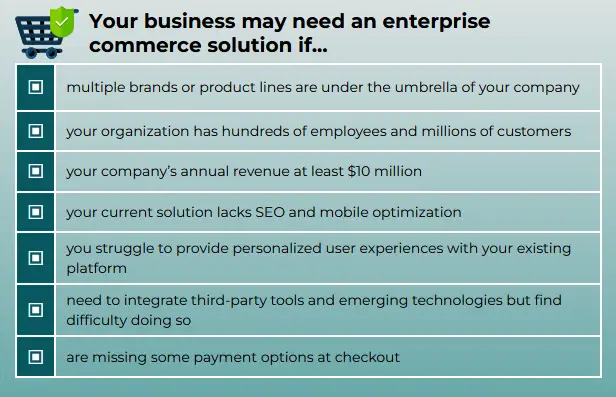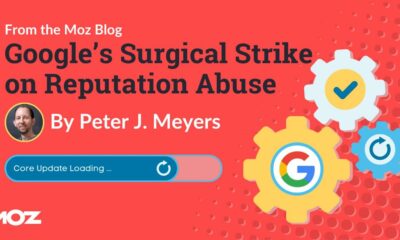MARKETING
The in-depth guide to enterprise commerce solutions and platforms

Did you know that almost 35% of customers switched brands last year due to changing needs or expectations? For enterprise commerce companies with digital transformation initiatives, this meant significant increases in customer acquisition. Unfortunately, the brands that couldn’t anticipate their customers’ needs lost their buyers and some revenue.
How can your business fall into the first category and be successful? The right enterprise commerce solution or platform is vital.
We’ll consider several factors when choosing the right solution. But first, let’s review what an enterprise commerce solution is.
Key takeaways:
- An enterprise commerce platform is an advanced solution that helps high-volume businesses sell products or services online and offline.
- The size and reach of a company and establishing if the existing commerce platform is meeting the company’s needs will determine if you need an enterprise commerce solution.
- When choosing an enterprise commerce solution, several factors are modularity, scalability, security and omnichannel capability.
What is an enterprise commerce solution?
Enterprise commerce businesses have more intrinsic needs than small ones. Enterprise commerce brands offer multiple goods or services and tend to have a global presence with annual revenues starting in the tens of millions of USD. These businesses can be retailers, manufacturers or distributors and work in B2B or B2C.
An enterprise commerce platform is an advanced solution that helps high-volume businesses sell products or services online and offline. With enterprise commerce solutions, brands can:
- Automate and streamline processes
- Boost overall organizational efficiency
- Adapt to change faster
- Get visibility on multiple digital touchpoints
- Widen their customer base by speeding up the buyer journey and building better customer relations
- Receive data-driven insights for strategic business growth
- Improve sales
Enterprise-level solutions typically have global localization features like time zone, currency and language customizations.
When are you ready for an enterprise commerce solution or platform?
How do you know if an enterprise commerce solution is a good fit for your business? Consider the following questions:
- Are multiple brands or product lines under the umbrella of my company?
- Does my organization have hundreds of employees and millions of customers?
- Is my company’s annual revenue at least $10 million?
- Does my current solution lack SEO and mobile optimization?
- Do I struggle to provide personalized user experiences with my existing platform?
- Do I need to integrate third-party tools and emerging technologies but find them challenging?
- Am I missing some payment options at checkout?
If you replied “YES” to at least five of these questions, you are ready for an enterprise commerce solution.

10 Things to consider when selecting a solution
Now that you’ve determined you need an enterprise commerce platform, how do you choose the right one? Here are ten items to consider.
1. Technology to future-proof the brand
Since the future is unpredictable, how can you integrate technology to future-proof your brand? The most straightforward way is to use a SaaS-based solution. Software-as-a-service solutions are cloud-based, so there is a constant investment in development and advancement. These continual efforts result in plenty of e-commerce platform options for large-scale businesses.
2. Modularity
A modular system is one with distinctive units that effortlessly come together or separate. Why is this significant? A modular solution allows a technician to tweak one of the components without affecting the function of others, meaning you can add, remove and replace components seamlessly.
3. Scalability
A scalable system can accommodate an increase in workload (e.g., more users, transactions, data storage.) This feature affords an organization several advantages:
- You buy what you need now, having a leaner product that suits current needs without extra density.
- It requires a lower up-front cost.
- Scalability allows for shifting priorities.
- The organization can use the same software for longer since it can grow with the business.
- Adding features to scalable software is less costly.
- The employee learning curve for using the software is not steep.
4. Speed
Is website speed critical? Take a look at these statistics:
- One in two visitors will leave a website that takes more than 6 seconds to load.
- Fifty percent of shoppers will abandon their carts if the page doesn’t load fast enough.
- Forty-six percent of customers blame the business’ lack of infrastructure to run a functional website when they experience slow page loads.
Therefore, ensure that your enterprise commerce solution can deliver excellent speeds even during heavy traffic.
5. Frequent automatic security updates
Security is the number one reason to have automatic updates in place. Data breaches, cyberattacks and identity theft are too common, and software vulnerabilities permit cyber criminals to access your company’s resources.
Also, technology is constantly evolving, and updates provide the latest features.
6. Artificial intelligence
AI can take customer data and provide reliable recommendations, leading businesses to be more data-driven. Furthermore, they can tailor product merchandising. Customer service agents leverage AI to assist them in responding to customer queries and complaints with empathy. Chatbots are AI-based and provide customers with a self-service portal for simple questions or issues.
7. Fast time-to-market
Time-to-market (TTM) is the time it takes from pitching a product or feature idea until it is available to customers. A fast TTM offers you a competitive edge, where you can react sooner to market changes and continuously be one step ahead of the competition. The ideal enterprise commerce solution will automate your processes, such as testing and deploying.
8. Omnichannel capability
Your commerce platform should enable businesses to promote goods and services across multiple channels like email, search engines and social media. Having the backend data in one central location is necessary for this capability.
9. Personalization
Personalization means creating a unique experience tailored to the individual customer and is essential because buyers expect it. At the outset, we mentioned that customers gravitate to businesses that can anticipate their needs and expectations, so an enterprise commerce platform must include this feature.
10. Third-party integration
Your commerce platform should integrate or include tools like a content management system (CMS), customer relationship management (CRM) system, enterprise resource planning (ERP) and more. You should be able to tie current and future business solutions for a complete view of your customer and organization data.
Partner with Optimizely for your enterprise commerce solution
Your capacity to harness modern technology to enhance performance and provide your customers with pleasant digital experiences is the difference between falling behind and being ahead of the curve. When It comes to the perfect enterprise commerce platform, Optimizely is the right choice.
Contact Optimizely today to elevate your customers’ experiences to the next level.
MARKETING
Google’s Surgical Strike on Reputation Abuse

These aren’t easy questions. On the one hand, many of these sites do clearly fit Google’s warning and were using their authority and reputation to rank content that is low-relevance to the main site and its visitors. With any punitive action, though, the problem is that the sites ranking below the penalized sites may not be of any higher quality. Is USA Today’s coupon section less useful than the dedicated coupon sites that will take its place from the perspective of searchers? Probably not, especially since the data comes from similar sources.
There is a legitimate question of trust here — searchers are more likely to trust this content if it’s attached to a major brand. If a site is hosting third-party content, such as a coupon marketplace, then they’re essentially lending their brand and credibility to content that they haven’t vetted. This could be seen as an abuse of trust.
In Google’s eyes, I suspect the problem is that this tactic has just spread too far, and they couldn’t continue to ignore it. Unfortunately for the sites that were hit, the penalties were severe and wiped out impacted content. Regardless of how we feel about the outcome, this was not an empty threat, and SEOs need to take Google’s new guidelines seriously.
MARKETING
18 Events and Conferences for Black Entrepreneurs in 2024

Welcome to Breaking the Blueprint — a blog series that dives into the unique business challenges and opportunities of underrepresented business owners and entrepreneurs. Learn how they’ve grown or scaled their businesses, explored entrepreneurial ventures within their companies, or created side hustles, and how their stories can inspire and inform your own success.
It can feel isolating if you’re the only one in the room who looks like you.
MARKETING
IAB Podcast Upfront highlights rebounding audiences and increased innovation


Podcasts are bouncing back from last year’s slowdown with digital audio publishers, tech partners and brands innovating to build deep relationships with listeners.
At the IAB Podcast Upfront in New York this week, hit shows and successful brand placements were lauded. In addition to the excitement generated by stars like Jon Stewart and Charlamagne tha God, the numbers gauging the industry also showed promise.
U.S. podcast revenue is expected to grow 12% to reach $2 billion — up from 5% growth last year — according to a new IAB/PwC study. Podcasts are projected to reach $2.6 billion by 2026.
The growth is fueled by engaging content and the ability to measure its impact. Adtech is stepping in to measure, prove return on spend and manage brand safety in gripping, sometimes contentious, environments.
“As audio continues to evolve and gain traction, you can expect to hear new innovations around data, measurement, attribution and, crucially, about the ability to assess podcasting’s contribution to KPIs in comparison to other channels in the media mix,” said IAB CEO David Cohen, in his opening remarks.
Comedy and sports leading the way
Podcasting’s slowed growth in 2023 was indicative of lower ad budgets overall as advertisers braced for economic headwinds, according to Matt Shapo, director, Media Center for IAB, in his keynote. The drought is largely over. Data from media analytics firm Guideline found podcast gross media spend up 21.7% in Q1 2024 over Q1 2023. Monthly U.S. podcast listeners now number 135 million, averaging 8.3 podcast episodes per week, according to Edison Research.
Comedy overtook sports and news to become the top podcast category, according to the new IAB report, “U.S. Podcast Advertising Revenue Study: 2023 Revenue & 2024-2026 Growth Projects.” Comedy podcasts gained nearly 300 new advertisers in Q4 2023.
Sports defended second place among popular genres in the report. Announcements from the stage largely followed these preferences.
Jon Stewart, who recently returned to “The Daily Show” to host Mondays, announced a new podcast, “The Weekly Show with Jon Stewart,” via video message at the Upfront. The podcast will start next month and is part of Paramount Audio’s roster, which has a strong sports lineup thanks to its association with CBS Sports.
Reaching underserved groups and tastes
IHeartMedia toasted its partnership with radio and TV host Charlamagne tha God. Charlamagne’s The Black Effect is the largest podcast network in the U.S. for and by black creators. Comedian Jess Hilarious spoke about becoming the newest co-host of the long-running “The Breakfast Club” earlier this year, and doing it while pregnant.
The company also announced a new partnership with Hello Sunshine, a media company founded by Oscar-winner Reese Witherspoon. One resulting podcast, “The Bright Side,” is hosted by journalists Danielle Robay and Simone Boyce. The inspiration for the show was to tell positive stories as a counterweight to negativity in the culture.
With such a large population listening to podcasts, advertisers can now benefit from reaching specific groups catered to by fine-tuned creators and topics. As the top U.S. audio network, iHeartMedia touted its reach of 276 million broadcast listeners.
Connecting advertisers with the right audience
Through its acquisition of technology, including audio adtech company Triton Digital in 2021, as well as data partnerships, iHeartMedia claims a targetable audience of 34 million podcast listeners through its podcast network, and a broader audio audience of 226 million for advertisers, using first- and third-party data.
“A more diverse audience is tuning in, creating more opportunities for more genres to reach consumers — from true crime to business to history to science and culture, there is content for everyone,” Cohen said.
The IAB study found that the top individual advertiser categories in 2023 were Arts, Entertainment and Media (14%), Financial Services (13%), CPG (12%) and Retail (11%). The largest segment of advertisers was Other (27%), which means many podcast advertisers have distinct products and services and are looking to connect with similarly personalized content.
Acast, the top global podcast network, founded in Stockholm a decade ago, boasts 125,000 shows and 400 million monthly listeners. The company acquired podcast database Podchaser in 2022 to gain insights on 4.5 million podcasts (at the time) with over 1.7 billion data points.
Measurement and brand safety
Technology is catching up to the sheer volume of content in the digital audio space. Measurement company Adelaide developed its standard unit of attention, the AU, to predict how effective ad placements will be in an “apples to apples” way across channels. This method is used by The Coca-Cola Company, NBA and AB InBev, among other big advertisers.
In a study with National Public Media, which includes NPR radio and popular podcasts like the “Tiny Desk” concert series, Adelaide found that NPR, on average, scored 10% higher than Adelaide’s Podcast AU Benchmarks, correlating to full-funnel outcomes. NPR listeners weren’t just clicking through to advertisers’ sites, they were considering making a purchase.
Advertisers can also get deep insights on ad effectiveness through Wondery’s premium podcasts — the company was acquired by Amazon in 2020. Ads on its podcasts can now be managed through the Amazon DSP, and measurement of purchases resulting from ads will soon be available.
The podcast landscape is growing rapidly, and advertisers are understandably concerned about involving their brands with potentially controversial content. AI company Seekr develops large language models (LLMs) to analyze online content, including the context around what’s being said on a podcast. It offers a civility rating that determines if a podcast mentioning “shootings,” for instance, is speaking responsibly and civilly about the topic. In doing so, Seekr adds a layer of confidence for advertisers who would otherwise pass over an opportunity to reach an engaged audience on a topic that means a lot to them. Seekr recently partnered with ad agency Oxford Road to bring more confidence to clients.
“When we move beyond the top 100 podcasts, it becomes infinitely more challenging for these long tails of podcasts to be discovered and monetized,” said Pat LaCroix, EVP, strategic partnerships at Seekr. “Media has a trust problem. We’re living in a time of content fragmentation, political polarization and misinformation. This is all leading to a complex and challenging environment for brands to navigate, especially in a channel where brand safety tools have been in the infancy stage.”
Dig deeper: 10 top marketing podcasts for 2024
-

 PPC7 days ago
PPC7 days agoHow the TikTok Algorithm Works in 2024 (+9 Ways to Go Viral)
-

 SEO6 days ago
SEO6 days agoHow to Use Keywords for SEO: The Complete Beginner’s Guide
-

 MARKETING7 days ago
MARKETING7 days agoHow To Protect Your People and Brand
-

 MARKETING4 days ago
MARKETING4 days agoAdvertising on Hulu: Ad Formats, Examples & Tips
-

 MARKETING5 days ago
MARKETING5 days agoUpdates to data build service for better developer experiences
-

 MARKETING1 day ago
MARKETING1 day ago18 Events and Conferences for Black Entrepreneurs in 2024
-

 MARKETING6 days ago
MARKETING6 days agoThe Ultimate Guide to Email Marketing
-

 SEO7 days ago
SEO7 days agoAutomate Multi-Site Reporting With Google Sheets And GSC API














You must be logged in to post a comment Login